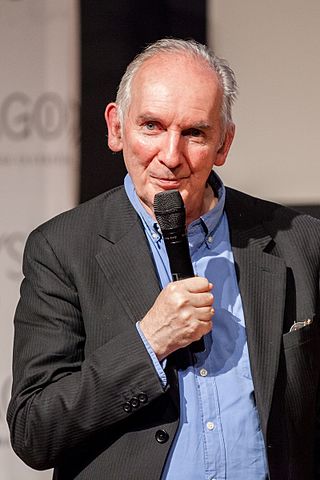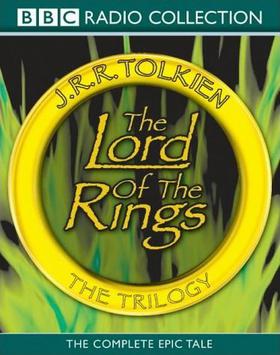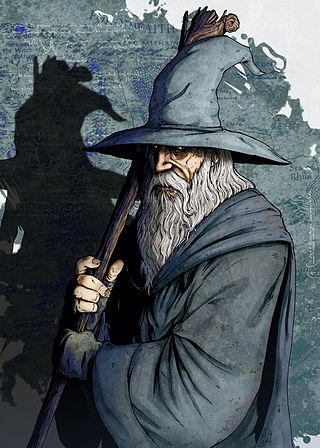Career
Radio writing and broadcasting
Sibley's first programme was Three Cheers for Pooh, broadcast on BBC Radio 4 on 14 October 1976 to mark the 50th anniversary of the publication of A. A. Milne's Winnie-the-Pooh . The programme was presented by actor Peter Bull, featured the voices of Norman Shelley and pianist and singer Antony Miall and was directed by John Tydeman, later Head of BBC Drama. [2]
Other features quickly followed and, in 1981, he co-wrote (with Michael Bakewell) BBC Radio 4's adaptation of Tolkien's The Lord of the Rings He also adapted C. S. Lewis's The Chronicles of Narnia and Mervyn Peake's Titus Groan and Gormenghast for Radio 4, receiving a Sony Radio Award for his Peake plays in 1985. He returned to Peake's writings in 2011 with The History of Titus Groan, a cycle of six one-hour plays for BBC Radio 4's 'Classic Serial' based on Titus Groan , Gormenghast , Titus Alone and Maeve Gilmore's Titus Awakes . Produced by Jeremy Mortimer, the series began transmission on Sunday 10 July with a cast headed by David Warner, Luke Treadaway and Miranda Richardson, and won the BBC Audio Drama Award 2012 for Best Adaptation. [3]
Other major radio dramatizations by Sibley include: John Bunyan's The Pilgrim's Progress ; Tolkien's Tales from the Perilous Realm ; Roald Dahl's Danny, the Champion of the World ; Lucy M. Boston's The Children of Green Knowe , Laurens van der Post's The Night of the New Moon, J. B. Priestley's The Thirty-First of June, Jeffrey Archer's A Matter of Honour , Frank Baker's Miss Hargreaves, James Thurber's The Wonderful O, two series of Ray Bradbury's Tales of the Bizarre, Ray Bradbury's The Illustrated Man and a six-part dramatization of T H White's The Once and Future King starring David Warner as Merlyn. 2016 saw the broadcasting by the BBC of his two-part dramatization of Richard Adams's Watership Down and the J. G. Ballard short story Track 12 .
His original radio plays include: ...And Yet Another Partridge in a Pear Tree, starring Penelope Keith, C. S. Lewis: Northern Irishman, and It's Too Late Now.
He was a contributor to and then regular presenter of the former BBC Radio 4 arts programme Kaleidoscope and the BBC World Service arts magazine, Meridian. He also presented the Radio 4 film programme, Talking Pictures, was a regular presenter of The Afternoon Shift and chaired the radio panel games Break A Leg and Screen Test.
He has also contributed to Radio 4's Last Word, Brief Lives, A Good Read, The Radio 2 Arts Show and Radio 3's Night Waves. He also presented several series of the BBC television programme, First Light. [4]
His features and documentaries for Radio 4, Radio 2 and the World Service have included programmes devoted to Sherlock Holmes, Jack the Ripper, Robin Hood, Dracula, Peter Pan, Winnie-the-Pooh, Alice in Wonderland and the life and work of Ambrose Bierce, Robert Raikes, Harry Houdini, Terry Pratchett, George Orwell, Roald Dahl, Ray Bradbury, Richmal Crompton, Fred Zinnemann, Frank Capra, Jim Henson, Paco Pena, James Galway, Marcel Marceau, Bob Hoskins and Julie Andrews.
Key series for BBC Radio 2, made in collaboration with producer Malcolm Prince, include Ain't No Mickey Mouse Business, Disney's Women, David Puttnam's Century of Cinema, Ain't No Mickey Mouse Music, No Place Life Home: A Judy Garland Story, Showman and Starmaker: A Tribute to Bill Cotton and, in Autumn 2010, a series of eight documentaries on aspects of The Musical that he both compiled and wrote. His interviewees for these series included Michael Caine, Richard Attenborough, Angela Lansbury, Margaret O'Brien, Dirk Bogarde, Roy E Disney, Robert Wise, Ken Annakin, Richard Curtis, Richard M Sherman, Leslie Briccusse, Bryan Forbes, Sandy Wilson, Tim Rice, James Rado and Edward Albee. He also wrote and presented a series on the history of film music, The Sound of Movies.
Sibley's book, Shadowlands, was serialized on Radio 2, read by Ian Richardson in what was one of the actor's last pieces of broadcast work.
Gillian Reynolds, then The Daily Telegraph's radio critic, gave him the accolade "magician of the airwaves".
In 1992 Sibley wrote much of the script for Jeff Wayne's Musical Version of Spartacus .
Journalism
Sibley has written as a columnist, reviewer and obituarist for The Times , The Daily Telegraph , The Independent , The Guardian , Times Literary Supplement , The Observer , The Listener , Radio Times , The Church Times and Films and Filming .
Publications
His books include The Disney Studio Story and Mickey Mouse: His Life and Times (with Richard Holliss); The Land of Narnia , illustrated by Pauline Baynes; The Treasury of Narnia (with Alison Sage); Shadowlands: The True Story of C. S. Lewis and Joy Davidman ; The Book of Guinness Advertising; a biography of Wilbert Vere Awdry, entitled The Thomas the Tank Engine Man; A Christmas Carol: The Unsung Story; Cracking Animation: The Aardman book of 3-D Film-making, (with Peter Lord); Chicken Run: Hatching the Movie; Three Cheers for Pooh ; and The Maps of Tolkien's Middle-earth with artist John Howe.
He is also the author of the children's book, The Frightful Food Feud, and has edited, among other books, The Pooh Sketchbook, The Pooh Book of Quotations and The Wisdom of C. S. Lewis.
The author of The Lord of the Rings: The Making of the Movie Trilogy and other books accompanying The Lord of the Rings , he subsequently wrote the official biography of the films' director, Peter Jackson: A Filmmaker's Journey.
His other books include The Hobbit: The Battle of the Five Armies – The Official Movie Guide, The Hobbit: The Desolation of Smaug – The Official Movie Guide, The Hobbit: An Unexpected Journey – The Official Movie Guide, The Making of The Pirates! In an Adventure with Scientists , Harry Potter Film Wizardry, The Golden Compass: The Official Illustrated Movie Companion, Mary Poppins: Anything Can Happen if You Let It (with Michael Lassell) and a retelling of 50 Favourite Bible Stories selected and read on CD by Cliff Richard and illustrated by Stephen Waterhouse. [5] In October 2016 he was one of four writers contributing new stories about Winnie-the-Pooh for a 90th birthday collection, The Best Bear in All the World . His story introduced a new character, Penguin, inspired by a vintage photograph of A. A. Milne and his young son, Christopher Robin, playing with the original teddy bear who became Winnie-the-Pooh and a plush toy penguin. The same month saw the publication of Taschen Books' The Walt Disney Film Archives. The Animated Movies 1921–1968 to which he contributed five critical essays on Disney films.
His Christmas book, Joseph and the Three Gifts, [6] published in September 2019, was described by Frank Cottrell Boyce as "a little masterpiece". The book was abridged and serialised (by the author) for broadcast in the Christmas week of 2021 on BBC Radio 4, where it was read by Alex Jennings and directed by Martin Jarvis.
In 2021, his fable Osric the Extraordinary Owl, illustrated by his friend Pauline Baynes, was privately published in a limited edition. He is currently editing a book of the letters of Walt Disney.
Sibley recorded DVD audio commentaries for Around the World in 80 Days (1956 film), Animal Farm (1954 film) and Fantasia (1940 film). He has also appeared on the bonus extras to a number of Disney Blu-rays and DVDs, among them Snow White and the Seven Dwarfs , Pinocchio , One Hundred and One Dalmatians , Mary Poppins , The Jungle Book , Sleeping Beauty , Beauty and the Beast , Alice in Wonderland and The Scarecrow of Romney Marsh as well as being included in the documentaries associated with various home media releases of The Lord of the Rings film trilogy. [7]
Sibley is also the editor of The Sunday Times Best-seller, J.R.R.Tolkien's The Fall of Númenor (2022), illustrated by Alan Lee and the winner of the Tolkien Society's 'Best Book of 2023' award. [8]











